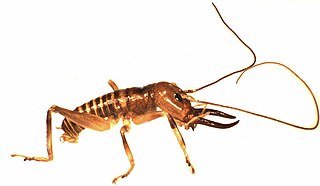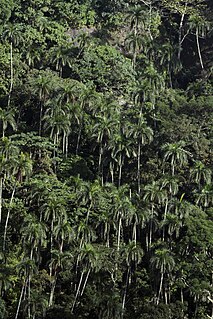Related Research Articles

The Nicobar pigeon is found on small islands and in coastal regions from the Andaman and Nicobar Islands, India, east through the Malay Archipelago, to the Solomons and Palau. It is the only living member of the genus Caloenas and may be the closest living relative of the extinct dodo, and the extinct Rodrigues solitaire.

The Northland tusked wētā, Anisoura nicobarica, is a rare monotypic wētā of the family Anostostomatidae, endemic to the northern half of Northland in New Zealand. It was originally described in the ground wētā genus Hemiandrus, but was later put into a newly-created genus, Anisoura. The type specimen was wrongly labelled as coming from the Nicobar Islands, so the species was named Anisoura nicobarica.

Bentinckia is a genus of palms in the family Arecaceae. The genus is named after William Henry Cavendish-Bentinck a colonial governor general of British India. There are two species of palms in this genus. namely Bentinckia condapanna and Bentinckia nicobarica.

Bentinckia nicobarica is a species of flowering plant in the family Arecaceae found to occur in the Nicobar group of islands in the Bay of Bengal. This is an endemic Palm occurring in Great Nicobar, Katchal, Nancowry and Car Nicobar Islands.The occurrence of this species in Andaman and Nicobar group of islands other than Katchal Island is yet to be confirmed as natural/escape or by human introduction. It is an endangered species according to IUCN Red List of Threatened Species, 2016 with Red List Category & Criteria as C2a ver 2.3. Living specimens of this taxon is conserving at Indian Botanic Garden, Howrah and at the Field Gene Bank of Jawaharlal Nehru Tropical Botanic Garden and Research Institute, Thiruvananthapuram in India.

The Nicobar treeshrew is a treeshrew species within the Tupaiidae. It is endemic to the Nicobar Islands where it inhabits the islands' rain forests. It is threatened by habitat loss.

The Nicobar shrew or Nicobar white-tailed shrew is a critically endangered species of mammal in the family Soricidae. It is endemic to the Great Nicobar Island of India.
Mangifera nicobarica is a species of plant in the family Anacardiaceae. It is endemic to the Nicobar Islands.

Cethosia biblis, the red lacewing, is a species of heliconiine butterfly belonging to the family Nymphalidae.
Hierodula nicobarica is a species of praying mantis in the family Mantidae.
Phacusa nicobarica is a moth of the family Zygaenidae. It was described by George Hampson in 1919. It is found on the Nicobar Islands in the eastern Indian Ocean.
Astathini is a tribe of longhorn beetles of the subfamily Lamiinae. It was described by Thomson in 1864.
Momisis is a genus of longhorn beetles of the subfamily Lamiinae.
Pleurobranchella is a genus of sea slugs, marine gastropod mollusks in the family Pleurobranchaeidae.
Momisis monticola is a species of beetle in the family Cerambycidae. It was described by Breuning in 1956. It is known from India.
Momisis submonticola is a species of beetle in the family Cerambycidae. It was described by Breuning in 1968. It is known from China and Laos.
Gnoma nicobarica is a species of beetle in the family Cerambycidae. It was described by Stephan von Breuning in 1936. It is known from the Nicobar Islands.
Marmaroglypha nicobarica is a species of beetle in the family Cerambycidae. It was described by Redtenbacher in 1868. It is known from the Nicobar Islands.
Mimabryna nicobarica is a species of beetle in the family Cerambycidae. It was described by Stephan von Breuning in 1938. It is known from the Nicobar and Andaman Islands.
Serixia nicobarica is a species of beetle in the family Cerambycidae. It was described by Stephan von Breuning in 1958.
References
- ↑ BioLib.cz - Momisis nicobarica. Retrieved on 8 September 2014.
| This Astathini article is a stub. You can help Wikipedia by expanding it. |